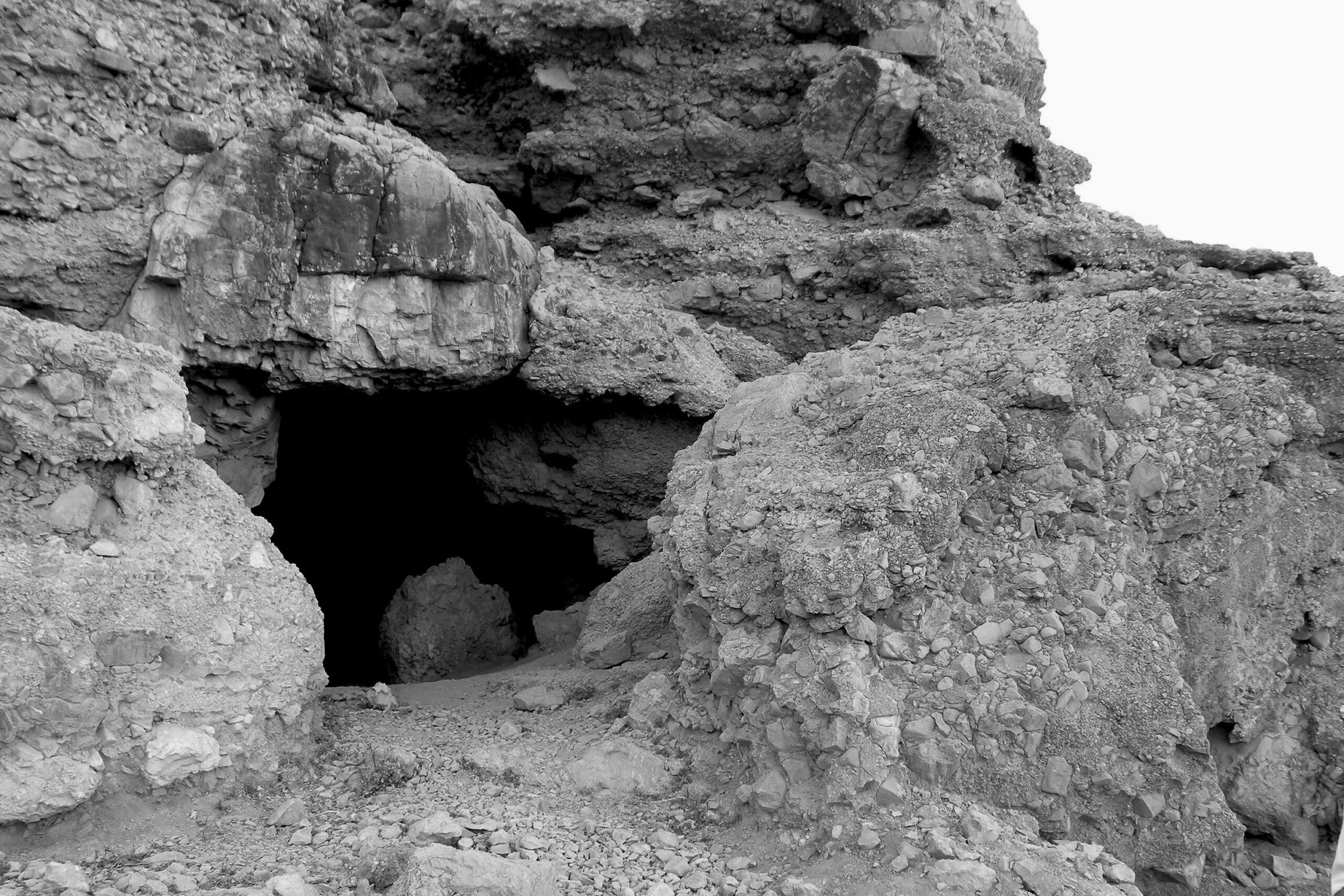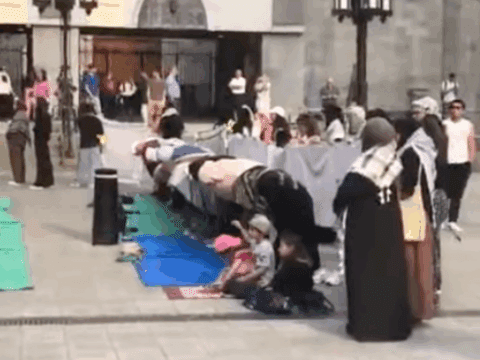Editor’s note: The discovery in 1947 of ancient biblical manuscripts in a rugged cave near the Dead Sea triggered a scholarly detective project that continues to this day. In the early 1950s, Rev. R.B.Y. Scott, a United Church minister and academic, participated in some of the initial excavations, as well as efforts to reclaim fragments that had fallen into the hands of antiquities dealers. Sixty years ago this month, Scott wrote this story about one of the Qumran caves that had yielded a trove of text fragments.
At one moment, the Beirut plane was high over the Jordan valley, with the tiny river below, squirming in torturous meanderings. Then, we were over the gardens and white buildings of modern Jericho, and saw the mound of the ancient town cut open like a melon by the picks of archaeologists. At almost the next moment, the gaunt hills rose to meet us, as the flaps were down and the plane was coming in for a landing. A road barrier with waiting cars swept past the window where the runway crossed the main road from Jerusalem to Nablus and Samaria. Then, I was in the airport’s waiting room with its unexpected lithograph of Alberta’s Lake Louise.
You may unsubscribe from any of our newsletters at any time.
The date was April 1955. After four years, I was returning to Jerusalem to see the fragments of the Dead Sea Scrolls, which had been recovered from the Bedouin finders with a grant from the John Henry Birks Foundation. They were to come to McGill University. Much had happened in the interval, and a good deal has happened since. In 1951, only the first of the Qumran caves had yielded up its treasures. A party of us had scrambled up the steep slope to spot it marked by a whitish pile of debris. On hands and knees, we worked our way into what was little more than a rock fissure. Pieces of pendant sandstone from the roof broke off easily in our hands. Had the cave not been discovered when it was, the roof might soon have collapsed as so many others have done, and the remarkable series of discoveries of ancient Jewish scrolls might never have begun.
The manuscripts from this first cave became known in 1948, about a year after their actual discovery. After many vicissitudes, they have now come to rest in the Israeli section of divided Jerusalem, with the exception of small pieces recovered later from the merchant who had acted as a go-between for the Bedouin. Since that time, no less than ten additional deposits have been found in the vicinity of the first cave, and more have come from three other sites a few miles to the south of the same wilderness. All of this is in the custody of the Jordan Department of Antiquities; until recently, it was being studied in the Jordan sector of Jerusalem but now has been removed for safekeeping to a bank vault in Amman.
McGill University’s contribution had gone to recover part of the immense number of scroll fragments removed from Cave Four by the Bedouin before the authorities got wind of what was going on. Four other institutions followed suit, yet it is by no means sure that all has yet been secured. From this cave alone came the remains of more than four hundred manuscripts in about 15,000 pieces. An international team of eight or nine scholars was assembled at the Palestine Archaeological Museum for the delicate and laborious task of assembling, reading and identifying all this, and the material from the other finds as well.
Needless to say, I lost no time in depositing my bags at the American School and heading for the magnificent museum erected by a Rockefeller grant, just outside the northeast corner of the old walled city. At the end of one of its cool stone corridors was a small green door, locked. Mr. Harding took me in. A very large room was almost filled with trestle tables covered with hundreds of glass plates. At one of them, a man was seated with intense concentration examining something through a magnifying glass. A tall figure in a black cassock moved along the tables, checking. Through an open door at the far end of the room came the sound of voices raised in learned argument. All over the world, scholars were waiting to hear what these colleagues of theirs in the Jerusalem “Scrollery” had been able to decipher.
The task was an immense one. The fragments were brought to the museum in cardboard boxes. Some of them were crumbled, others were stuck together. All were extremely dry and brittle, and had to be handled with delicacy. The material is sheepskin or goatskin, with some examples of the ancient paper made from the pith of a marsh reed known as papyrus. The writing on many was almost illegible until photographed on film sensitive to infrared light. But before this could be done, the pieces had to be softened in a humidifier — but not too much, or they would disintegrate. Then began the work of sorting and matching the fragments by comparing the texture and colour of the material, as well as the characteristics and peculiarities of the writing. It was a jig-saw puzzle with most of the pieces missing.

The identification of the manuscripts was relatively easy when they contained the text of Old Testament books or other works previously known. But many of the books from the Qumran library are Jewish religious writings previously unheard of. From what can be read of their contents, they have been given such titles as “Description of the New Jerusalem,” “Liturgy of the Tongues of Fire” and “Words of the Book spoken by Michael to the Angels.”
The most important finds for Christian scholarship are manuscripts of the Hebrew Bible, of the Apocryphal books on the margin of the Old Testament, and of writings that illustrate the beliefs and organization of the sect to which this collection belonged, and throw light on the background of the New Testament. We now have copies of Old Testament books about a 1,000 years older and nearer to the originals than any previously known — manuscripts actually in use in Palestine during the lifetime of Jesus. Most of these are very similar to the text of our printed Hebrew Bibles, so that we can see how carefully the later copyists did their work. But there are also some manuscripts that differ considerably in detail (though not in substance) from the traditional form, much as the Greek version of the Old Testament differs. These will help to clear up obscurities in the traditional text where it has suffered copyists’ errors.
The Apocryphal books come from the inter-testamental period; sometimes, they have been accepted as scripture and sometimes they have not. The Epistle of Jude quotes from the Book of Enoch as if it were in the Bible. These books had come down to us only in later translation. Now large parts of them have come to light in the original Hebrew or Aramaic.
It seems probable that the Jewish religious community, from whose library the Qumran scrolls have come, was part of the Essene movement. The Essenes are unmentioned in the New Testament, but from what was already known about them from ancient authors, it was seen that they had real affinities in beliefs and organization with the primitive Church. This has become even more evident from the new discoveries although the claim made by some that Christianity was only a derivative from Essenism is nonsense. Both groups thought of themselves as the faithful remnant and the people of the New Covenant, and applied to their own situation and experience the prophecies of the Old Testament. Both believed that men could be cleansed of sin, not by religious ceremonies, but only by the justifying grace of God. Both were profoundly concerned with the constant moral struggle in the heart of man, where “the flesh lusted against the Spirit, and the Spirit against the flesh.” Each followed a righteous Teacher to whom had been revealed the meaning of the ancient prophecy. Many phrases and ideas in the Scrolls sound like echoes of the New Testament — “The children of light,” “the poor in spirit,” “witnesses of the truth,” “the community,” “men of God’s favour.” The crucial difference is that though the Covenanters’ “Teacher of Righteousness” was persecuted and died, there is no suggestion that he was the Son of God who died an atoning death. There is no Resurrection faith. The Scrolls show us, not the source, but the background of Christian beginnings.
One day, soon after my arrival, Father de Vaux drove me to see the excavated ruins of the Qumran community’s headquarters. Near the mouth of the Jordan, we turned off the road onto a rough track by the Dead Sea shore. We drove across the plain for about a mile; then de Vaux put the old station wagon into low gear and charged up a home-made “road” to a terrace that was about 200-feet high and jutted out at the base of the frowning sandstone cliffs. Here were the buildings where the Covenanters lived, worked and prayed, until the Roman army came and burned their “monastery” in the Spring of the year of our Lord 68. Here were their council chamber and their assembly hall, their cisterns for ritual baths and the room where they sat at long tables of plastered brick to copy their sacred writings. They had hidden their precious scrolls one far-off day when disaster threatened, “in dens and caves of the earth.”
A razor-back ridge jutted out from the terrace to overhang a deep ravine. Along this, we scrambled almost to its end and then down some rough-cut steps to a hole through which we dropped into Cave Four. This cave had been enlarged by human hands. The roof was domed, and in the walls were blacked niches for lamps. Through one aperture, one looked down into the ravine through another to the lazy blue of the Dead Sea. Here on the floor, a heap of precious manuscripts, liking our day with the time of Christ, had lain for nearly 19 centuries, slowly disintegrating in the dusty silence.
This story first appeared in The Observer’s June 2017 issue with the title “Seeing the Dead Sea Scrolls.”











